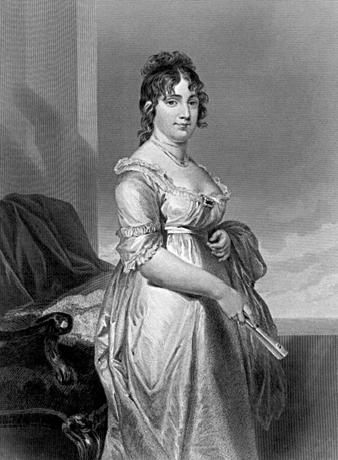The British were coming. Again. On the night of Aug. 24, 1814 — 200 years ago — the Battle of Bladensburg was a rout by British invaders against American soldiers and local militia. First lady Dolley Madison had overseen a victory dinner preparation at the President’s Mansion on Pennsylvania Avenue, expecting about 40 guests, and all was ready for the table. No one arrived but the British.
News came to the popular and politically savvy first lady of the catastrophe for the Americans: their capital city was in direct peril from Gen. Robert Ross and his troops. A carriage arrived at the White House from the owner of Bellevue in Georgetown — later known as Dumbarton House. Charles Carroll was the cousin of signer of the Declaration of Independence Charles Carroll of Carrollton and a close friend of President James Madison and James Monroe. He was also a cousin of Archbishop John Carroll, founder of Georgetown College, the only higher school of learning in the capital in 1814. He convinced Dolley to leave.
You see, as in our time to a lesser extent, everyone knows everyone in Washington — and many were related by family and marriage. With protestors nearby cursing “Mr. Madison’s War,” the carriage pulled away from the White House toward the west and up to the hillside home in Georgetown. Dolley had saved items from the James Hoban-designed building — including the famous portrait of President George Washington.
The White House would soon be set alight by disciplined troops — veterans of the Napoleonic Wars and a few of whom disagreed with what they would do. Still amazing to consider: British soldiers walked through the empty White House, enjoyed the wine and prepared food before setting the fire. They gathered furniture in center spots, broke the windows and threw oil-soaked, rag-wrapped poles through them — and let it roar. Take nothing but leave it a smoldering heap.
Scorch marks remain on the restored building, now so magnificent and such a symbol of power. During a 2012 visit, President Barack Obama said to British Prime Minister David Cameron of foreign troops at the White House in 1814: “They made quite an impression . . . They really lit up the place.” In the fear and confusion of that night 200 years ago, nothing so jocular assured America’s future greatness. Dolley with other families arrived at Dumbarton House, which had been owned by Register of the Treasury Joseph Nourse, whose son married the daughter of Anthony Morris, a lifelong friend of Dolley.
Living in Philadelphia and widowed, Dolley had been intro- duced to the bachelor James Madison by Morris and Aaron Burr. Later, Dolley would attempt to match her son Payne Todd with the delightful Phoebe Morris — who also knew the family at Tudor Place — to no avail. That hot and stormy August night, Dolley did not know where her husband, the President of the uncertain United States, was.
Carroll and other Georgetowners met with British troops to beseech them not to advance past Rock Creek. The troops’ instructions were always only to damage the small amount of gov- ernment buildings the young republic had — because Americans had vandalized the capital of Canada. Georgetown was safe, as it looked at the flames in Washington City. Looking too were Major George Peter of Tudor Place, head of the Georgetown Artillery, and another under his command, Francis Scott Key, whose family house was on Bridge (M) Street. Already the Key children had been taken to Frederick, Md., and wife Polly stayed behind for her beloved Frank, who would still have another mission to perform in this war. All Washingtonians — and soon enough of all America — were ashamed. Shaken but resolute, Dolley, the Carrolls and oth- ers pushed on to Virginia. She stayed two nights around McLean at Rokeby Farm and Salona near what would become — yes, that’s right — Dolley Madison Boulevard. She saw her husband at Wiley’s Tavern near Great Falls and also stopped at Minor Hill in Arlington. Finally, she and the president were back in Washington after four days and later made the Octagon House at 18th Street and New York Avenue, NW, their temporary home.
It was there that Carroll’s eldest son, Henry Carroll, who served as Henry Clay’s private secretary during peace treaty discussions at Ghent, Belgium, arrived to tell the Madisons and their guests that the War of 1812 was over. Applause erupted, and a nightlong celebration began for all. And quite a few had already met one night or another — as many of us do today — at one of Georgetown’s crown jewels, Dumbarton House. The country and city rose out of the ashes to become itself.


